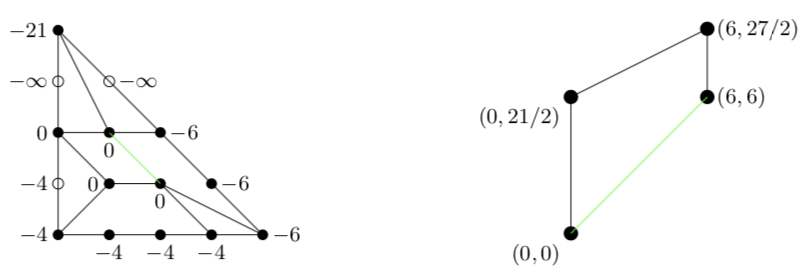Type (000)
Plane quartics of type (000)
A tropical curve \(C\) of type (000) is of the form

Due to symmetry, we may assume that \(b\leq c\leq a\). It is embeddable as a tropical quartic curve in \(\mathbb{R}^2\) if \(\max(d,e)\le a\), \(\max(e,f)\le b\) and \(\max(d,f)\le c\), such that
at most two of the inequalities may hold as equalities,
if two hold as equalities, then either \(d,e,f\) are distinct and the edge \(a,b\) or \(c\) that connects the shortest two of \(d,e,f\) attains equality or \(\max(d,e,f)\) is attained exactly twice and the edge connecting the longest two does not attain equality.
To illustrate how a curve is embeddable as a tropical quartic curve in a tropical plane, consider the following configuration of lengths which does not satisfy any of the previous three inequalities:
The idea is to construct a highly degenerate tropical plane quartic of correct type (000) and with edges of correct lengths \(a,b,c\), whose edges \(d',e',f'\) of too short lengths can be enlarged using a modification each. For our example, consider the following quartic polynomial:
poly g = (-t21+t15+t6)*x4+(-2t21+2t6)*x3y+(-2t15+t6)*x2y2+t15*y4+(2t22-4t15+t4)*x3+(2t22-4t15+2t4+1)*x2y+(t4+1)*xy2+(3t22-8t15-3t6+4t4)*x2+(-4t21-2t20-2t6+6t4+1)*xy+(-3t21-t20+2t4)*y2+(-4t21-2t20-2t6+5t4)*x+(-2t22-6t21-2t20+4t15+4t4)*y+(-t22-3t21-t20+3t15+2t4);
drawTropicalCurve(g,"max");
Using three modifications, we will see that the edges of higher multiplicity hide cycles of desired lengths:
The edge of length \(d\)
To show that the edge of length \(d'\) hides an edge of length \(d=21\), we modify \(g\) along \(w_x=w_y\) using \(z_0=x+y\), whose projection onto the \(z_0y\) axis yields (\(y\) remaining the vertical direction):
poly g0 = subst(g,x,x-y);
drawTropicalCurve(g0,"max");

The edge of length \(e\)
To show that the edge of length \(e'\) hides an edge of length \(e=22\), we modify \(g\) along \(w_y=0\) using \(z_2=y+1\), whose projection onto the \(xz_2\) axis yields (\(x\) remaining the horizontal direction):
poly g2 = subst(g,y,y-1);
drawTropicalCurve(g2,"max");

The edge of length \(f\)
To show that the edge of length \(f'\) hides an edge of length \(f=20\), we modify \(g\) along \(w_x=0\) using \(z_1=x+1\), whose projection onto the \(z_1y\) axis yields (\(y\) remaining the vertical direction):
poly g1 = subst(g,x,x-1);
drawTropicalCurve(g1,"max");

